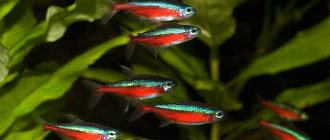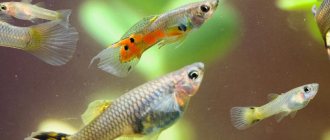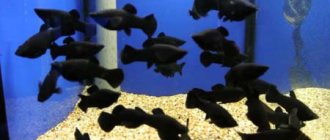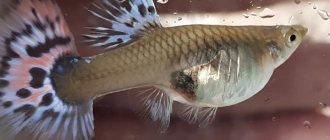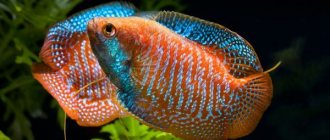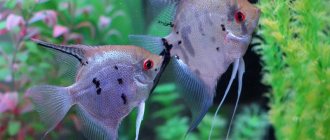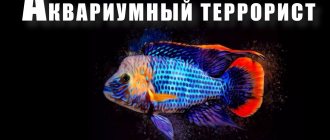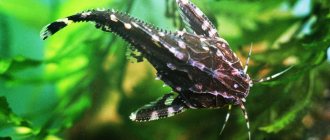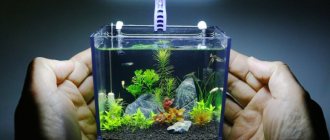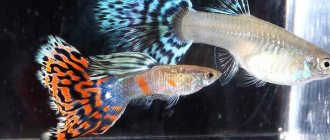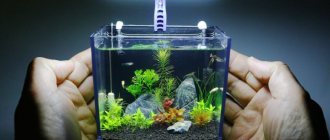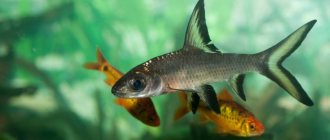Neons are small, beautiful, active aquarium fish that reproduce by spawning. Neons reach sexual maturity at the age of 6-8 months and retain reproductive functions until 4-5 years. To get offspring from these fish, you need to create special conditions for them. If everything is done correctly, you can see how neon fish reproduce. The most favorable time for spawning is from October to January.
Selection of producers and their preparation for spawning
For spawning, it is necessary to select the most promising representatives of the flock. The selected fish must have a healthy appearance, high mobility and bright coloring.
Females and males are distinguished according to the characteristics indicated in the following table.
| Differences between female and male neons | ||
| Characteristic sign | Males | Females |
| Size | More miniature | Larger ones |
| Stomach | Flat | Round, especially before spawning |
| neon stripe | Straight | With a break in the middle |
Females can spawn every week; males can produce milk twice a month. In individuals ready to reproduce, sexual demorphism is especially pronounced: in males, the swim bladder stands out and moves towards the anus, in females the abdomen enlarges and is rounded.
At least two weeks before spawning, future spawners should be isolated from the flock and placed in different containers. During this period, the male and female should be fed intensively and variedly with live food.
ATTENTION: It is advisable to include daphnia, cyclops and small bloodworms in the diet of future breeders. It is better to avoid enchytraeus and tubifex plants. The temperature of the water in the containers should be reduced to 20°C.
Return to content
Male
Features of mating games
When males and females find themselves in the same tank, they will fussily move around it for a while, swimming above the leaves. Neons breed mainly at dawn, so it is recommended to connect them in the evening so that they have time to get acquainted.
The mating dance of veiled neons.
As soon as the female begins to spawn, the males begin to attack her. The one who catches it first will win. When the male overtakes the female, he touches her tightly, and they turn at the same time. The dorsal fin lies on the female. When the right moment comes, the fish bend synchronously, and the moment the eggs and sperm fall out coincides.
Preparing the spawning tank
While the female and male are preparing for spawning, it is necessary to prepare a spawning tank for them - a small aquarium or an all-glass container with a volume of 6-10 liters, which is easy to wash and disinfect. It is best to use an elongated aquarium about 40 cm long for this. The prepared container should be disinfected with a weak solution of potassium permanganate, and then rinsed thoroughly with clean water.
The walls of the spawning area should be shaded with old newspapers or thick paper. You can leave the front surface of the vessel open and watch the fish spawn through it.
The light in the spawning tank should be dim and not directed. The top of the vessel should be covered with a glass lid, since during mating the fish are very active and can jump out of the container.
There is no need to pour soil into the spawning tank; it is best to put a piece of Java moss, a nylon mesh, tangled fishing line, a washcloth or willow roots collected in water on the bottom. You can attach several bushes of cryptorina or fern to the bottom.
IMPORTANT: Catfish and snails, which will happily feast on fresh eggs, should not be allowed into the spawning area. In a short time they can clear all the internal surfaces of a reservoir of eggs.
Return to content
DESCRIPTION, APPEARANCE, BUILDING
Neons are highly prized among aquarists. These fish are a real decoration for an aquarium. There are bright neon stripes on their body. Despite the bright colors, the fish do not distract, but, on the contrary, emphasize the beauty of the design created in the aquarium.
Neons are schooling fish and look great in an aquarium. Their bright shiny red or blue stripes along the body flash spectacularly in reflected light. This distinctive feature, which gives the fish a resemblance to neon signs, was the idea for their name.
The body of the fish is elongated and slightly flattened on the sides. On average, the length of neons is from 2.5 to 5 cm. The fish have a relatively small mouth, transparent fins, of which the anal one is longer than the dorsal one. Fishes of the order Characinidae are characterized by the presence of an adipose fin. It has no bony rays. The adipose fin is not paired and is located behind the dorsal fin.
It is noteworthy that in males the neon stripe is a straight line, while in females it has a slight break in the middle. Therefore, a specialist can easily distinguish a male from a female.
Most often in aquariums you can see red, blue and black neons.
black neon
red neon
blue neon
Requirements for water composition
Neon spawning requires soft, purified water. You can take distilled water and add a glass of water from a community aquarium to it. You can also use regular tap water, left to stand for several days and then heated to the desired temperature. The water for the spawning tank must settle and be saturated with oxygen. Its temperature should be brought to 22-25°C.
Neons can lay eggs in water of any hardness, but fertilization can only occur in soft water with a hardness of 0.5 to 4 units (the ideal value is about one).
To slow down the proliferation of bacteria in the aquatic environment, it is necessary to maintain acidity at 5.5-6 units. You can acidify the water using a decoction of oak bark, alder cones, peat decoction or special preparations that can be bought at a pet store.
Water for spawning must meet the following parameters:
- water column height – 15 cm;
- water temperature – 22-25◦C;
- hardness – 0.5-4 units;
- acidity – 5.5-6 units.
Return to content
Female
Reproduction in a community aquarium
Providing neon spawning in a common aquarium is a troublesome task. In order for the eggs to ripen correctly, certain conditions must be created in the tank, but they cannot guarantee a successful spawning outcome. Professionals recommend doing special spawning for the fish.
Compliance with the following water parameters will increase the likelihood of reproduction in a common tank:
- hardness - no more than 40;
- pH level – up to 5.0;
- temperature – up to 2500С – 260С.
You need to place 3-4 plant branches in the aquarium on which the eggs will be attached. It is recommended to use myriophyllum.
Eggs spawned in a community aquarium have less chance of maturing.
Nothing will interfere with mating games and fertilization of eggs in a common aquarium. But there is a danger to the eggs. They lie on the leaves of plants, stay there for several hours, after which they come off and fall to the ground. If you do not take care of moving it to a safe place in a timely manner, the eggs will serve as food for other aquarium inhabitants.
Spawning
Future breeders are transplanted into the spawning tank in the evening and are not fed after that. For spawning, you can use a couple of fish, or a female and two males. In the latter case, the more agile male wins, who fertilizes the eggs.
Spawning begins closer to dawn and lasts about 4 hours. During spawning, the female lays 50 to 300 eggs in a chaotic manner, and the male actively pursues her and performs a characteristic mating dance. Tiny eggs, coated with a special adhesive substance, attach to algae, stones or other suitable surfaces.
ATTENTION: Immediately after the end of spawning, the pair should be transplanted into a common aquarium. If this is not done, the new parents may eat all their offspring.
For disinfection, the drugs Tripaflavin, Methylene Blue or General Tonic are added to the spawning area, which help stop the proliferation of bacteria.
Light is harmful to sensitive eggs, so cover the vessel with an opaque material and put it in a dark place, such as a closet.
Return to content
Breeding unusual fish
- Breeding must be done under total control; disruption of the usual life that nature has created can jeopardize the laying of eggs.
- Before placing them in a common aquarium, separate them into different jars, then do five short introductions.
- The male ejects milk twice as rarely as the neon female is able to put off play.
- During reproduction, anatomical differences are clearly expressed.
- In girls, the belly begins to round, in boys the bladder moves to the hole at the tail.
Before breeding begins, water is prepared. Flow-through is suitable, provided that it is infused for a couple of days in a glass vessel. The water is heated to 25-26 degrees, hardness 2-4o, acidity 6.5-7.0 pH. If the appropriate water balance characteristics are maintained, most eggs will be fertilized and mature. The aquarium is selected to be approximately 30-50 liters in size to breed these individuals.
In order for the fish to reproduce, you need to provide nutritious aquatic plants and lay Java moss. Neon aquarium fish should get used to each other. Therefore, it is better to put it into one tank before going to bed, before turning off the lights. Thus, you can expect that the game will be swept out by morning. Homemade neons are in different conditions from neons that live in nature, but the actions in the process of fertilization are not at all different. Several males are released for one female. A fight breaks out between them when the female attacks. The most nimble ones can cope thanks to their readiness. Before laying eggs, a pair of neons float above the aquarium plants, and then the pregnant neon randomly lays eggs on them.
Initially, the eggs are sticky in consistency, and when they fall on plants, they are attached to the leaves, but at the slightest vibration of the water, they fall to the bottom of the container. For this reason, there is no need to lay out soil. Its base can damage the thin surface of the neon spawning area. After breeding, four hours later, the pair must be caught with a net from the tank, otherwise the “parents” may eat the laid eggs, which will harm the breeding of the neon fish.
The appearance of babies
24 hours after spawning, the first larvae will appear from the eggs. But first, the aquarist should carefully examine the eggs and carefully remove the dead units with tweezers. Dead eggs can be easily distinguished from live ones as they become white and opaque. If such eggs are not removed, the water in the spawning tank will deteriorate.
Babies born from eggs spend the first four days of their lives almost motionless and receive nutrition from the gall sac. On the fifth day, they begin to move around the pond and eat.
For several weeks, the fry see very poorly and are guided mainly by light (this feature is called phototaxis). Therefore, the entire aquarium needs to be darkened, leaving only one corner illuminated. In this corner the ciliates necessary for feeding the babies will accumulate. Moving towards the light and entering the illuminated area, small fish begin to actively absorb plankton. As a result, all young animals remain well-fed and survive.
Return to content
HABITAT
The birthplace of neon is South America. In Peru, Colombia, and Brazil you can find these amazing fish in their natural habitat. The element of neon is calm waters. Therefore, they prefer slow-flowing tributaries of large rivers, the waters of which are rich in humic substances, to fast flows, which gives them a brown tint. The optimal conditions for the life and reproduction of neons are soft and acidic water. These are the conditions that are created in rivers flowing in the shadow of tropical forests. Decaying leaves, regular rains, and a large layer of silt make the water soft and acidic.
Neon habitat in nature
Feeding the young
The fry should be fed frequently, in small portions. Kids really like the mixture of zooplankton and rotifers. The diet of neon babies can be diversified by pureed boiled egg yolk and ciliates. Over time, small fish become accustomed to nauplii and cyclops.
When the neon chicks are two weeks old, the darkening begins to gradually be removed from the spawning area. At three weeks, the colorless fry acquire a characteristic neon shine. By the age of one month, small fish should be completely accustomed to normal lighting. By one and a half months, the water hardness should be brought to the usual level, new food should be introduced into the diet and the young animals should be transplanted into a regular aquarium.
Return to content
STORY
For the discovery of neons and their appearance in our aquariums, we should thank the French researcher Auguste Rabot. It was he who first discovered these fish in Peru, in the Putumayo River. The beauty of the fish literally bewitched Auguste. Being a very enterprising man with a touch of adventurism in his soul, he decided that he could make good money by exporting them.
In 1935, the first copies of neon were first delivered to Europe and the USA. Aquarists really immediately fell in love with these fish, they became very popular. The fact that neons did not require complex maintenance was an additional plus. Auguste Rabot received huge dividends from his find. The fact is that in artificial conditions problems arose with the breeding of neons. In the first years, no one simply succeeded, so Rabo became a monopolist in the supply of neon to Europe.
Some of the first copies were donated for advertising purposes to William Innesi, an aquarium enthusiast and popularizer. He, in turn, gave the fish to his friend, George Myers, who made the first scientific description of a new species - blue, or ordinary neon, which he named in honor of his friend.
For the first time, it was possible to obtain offspring under artificial conditions in Germany. This phenomenon was even called the “German miracle.” Over time, it became clear that the secret of this “miracle” was in the softness of the water that was used to contain neons. The information obtained served as an impetus for new research that discovered the mechanisms of influence on the successful reproduction of neons.
Maintenance of spawners after spawning
As for the producers, after spawning they begin a rest period lasting 4-5 months. At this time, there is no need to place the male and female in different aquariums. The fish should be limited in diet, exclude high-calorie foods in the form of enchytraea and tubifex and add daphnia and cyclops instead. It is best to reduce the water temperature in the aquarium to 17-19◦C.
Thus, the reproduction of neons is a troublesome matter, but quite real. By giving your pets a little attention and care, the aquarist can get healthy offspring from them, which will replenish the existing population and will delight the eye for a long time with its beautiful neon shine.
Return to content
Differences between the sexes
At rest, neochiki almost do not differ in gender. But during spawning, the differences between male and female are more obvious.
The gender of a fish can be determined by the following characteristics:
- the male individual is approximately 5 mm smaller than the female;
- the blue (neon) stripe running through the entire body of the male has clear, even outlines, while the female has a stripe with a bend starting closer to the middle of the body;
- females are more rounded in shape and have an enlarged abdomen.
COMPATIBILITY
Despite their relationship with piranhas, neons are one of the most peaceful and non-aggressive fish. They get along well with other peaceful, medium-sized aquarium fish. Their neighbors may well be guppies and various species of viviparous carp, as well as rasboras, ancistrus, tetras, cardinals, etc. Amphibians and large aquarium inhabitants can react to neons as potential food. When deciding on a location, you should understand that if the neon can fit into another fish’s mouth, it can be eaten. Neons should not be allowed to be adjacent to territorial fish and predator fish.
Interesting Facts
- Neons made aquarists think about the composition and quality of water, which marked the beginning of aquarium chemistry. To create water suitable for neon breeding, they specifically looked for “soft, spawning water.” These studies raised the aquarium hobby to a higher level.
- In the wild, the development of eggs and young neons occurs in the twilight environment of shallow tropical waters. These are the conditions that need to be created in a home aquarium in anticipation of neon offspring.
- It is curious that neons themselves cannot glow. Their neon glow is the result of reflection and refraction of sunlight.
- The scales that cover the skin of these creatures are composed of chromophores. Chromophores contain pigment and produce a characteristic neon-metallic sheen from neon blood.
- Science does not yet have an answer to the question of why neons need an unusually bright and brilliant color. It is believed that this coloring attracts a couple during the spawning period. According to another version, the neon reflections of a scattering flock confuse attacking predators, performing a protective function.
Health
Neons have the ability to lose their brightness during the night. This makes them less accessible to predators. But if the color disappears during the daytime, this may mean that the fish is sick.
The reasons that can affect the health of individuals can be different:
- insufficient oxygen;
- improper feeding (usually overfeeding);
- water temperature (below 15-16 C°);
- water pollution;
- pathogens.
Neons are most often susceptible to the following diseases:
Plistiphorosis
This is the most common disease that kills neon fish. Its second name is “neon disease”. The fungus affects the muscles. The first symptom is a pale color and neon stripe. As the disease progresses, the fish becomes completely discolored and swims on its side or upside down. Then he dies. The disease is contagious, so the sick individual must be quarantined or killed. There is no treatment.
Saprolegniosis
The causative agent is also a fungus. The main causes of infection are poor aquarium hygiene, unbalanced nutrition and overcrowding. You can notice that the fish is sick by a spore-like coating and gluing of the fins.
